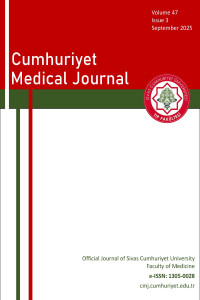Editorial
Manyetik Rezonans Elastografi: Karaciğer Fibrozisinin Değerlendirilmesinde Yeni Bir Dönemin Başlangıcı
Abstract
Manyetik rezonans elastografi (MRE), karaciğer fibrozisinin non-invaziv değerlendirilmesinde güvenilir ve tekrarlanabilir bir yöntemdir. Biyopsiye alternatif olarak tüm karaciğerde kantitatif sertlik ölçümü yapar. Yeni geliştirilen 3D MR elastografi, hacimsel değerlendirme ile klinik uygulamalarda daha güçlü bir potansiyel sunmaktadır.
References
- 1. Venkatesh SK, Ehman RL. Magnetic resonance elastography of the liver: clinical applications. J Comput Assist Tomogr. 2014;38: 544–549.
- 2. Singh S, Venkatesh SK, Wang Z, Miller FH, Motosugi U, Low RN, et al. Diagnostic performance of magnetic resonance elastography in staging liver fibrosis: a systematic review and meta-analysis of individual participant data. Clin Gastroenterol Hepatol. 2015; 13: 440-451.
- 3. Hsu C, Caussy C, Imajo K, Chen J, Singh S, Kaulback K, et al. Magnetic Resonance vs Transient Elastography Analysis of Patients With Nonalcoholic Fatty Liver Disease: A Systematic Review and Pooled Analysis of Individual Participants. Clin Gastroenterol Hepatol. 2019; 17: 630-637
- 4. Yin M, Ehman RL. MR Elastography: Practical Questions, From the AJR Special Series on Imaging of Fibrosis. AJR Am J Roentgenol. 2024; 222: e2329437.
- 5. Qiu C, Glaser KJ, Owusu N, Li J, Wu H, Venkatesh SK, et al. Acquisition Efficiency and Technical Repeatability of Dual-Frequency 3D Vector MR Elastography of the Liver. J Magn Reson Imaging. 2025; 61: 1416-1425.
Year 2025,
Volume: 47 Issue: 3, 1 - 2, 30.09.2025
Abstract
Magnetic resonance elastography (MRE) offers a reliable, non-invasive assessment of liver fibrosis by quantitative stiffness measurement. As an alternative to biopsy, it offers assessment of the entire liver, and the recent development of 3D MRE extends its clinical potential by providing volumetric coverage.
References
- 1. Venkatesh SK, Ehman RL. Magnetic resonance elastography of the liver: clinical applications. J Comput Assist Tomogr. 2014;38: 544–549.
- 2. Singh S, Venkatesh SK, Wang Z, Miller FH, Motosugi U, Low RN, et al. Diagnostic performance of magnetic resonance elastography in staging liver fibrosis: a systematic review and meta-analysis of individual participant data. Clin Gastroenterol Hepatol. 2015; 13: 440-451.
- 3. Hsu C, Caussy C, Imajo K, Chen J, Singh S, Kaulback K, et al. Magnetic Resonance vs Transient Elastography Analysis of Patients With Nonalcoholic Fatty Liver Disease: A Systematic Review and Pooled Analysis of Individual Participants. Clin Gastroenterol Hepatol. 2019; 17: 630-637
- 4. Yin M, Ehman RL. MR Elastography: Practical Questions, From the AJR Special Series on Imaging of Fibrosis. AJR Am J Roentgenol. 2024; 222: e2329437.
- 5. Qiu C, Glaser KJ, Owusu N, Li J, Wu H, Venkatesh SK, et al. Acquisition Efficiency and Technical Repeatability of Dual-Frequency 3D Vector MR Elastography of the Liver. J Magn Reson Imaging. 2025; 61: 1416-1425.
There are 5 citations in total.
Details
| Primary Language | English |
|---|---|
| Subjects | Medical Education |
| Journal Section | Editorial |
| Authors | |
| Publication Date | September 30, 2025 |
| Submission Date | September 29, 2025 |
| Acceptance Date | September 29, 2025 |
| Published in Issue | Year 2025 Volume: 47 Issue: 3 |

